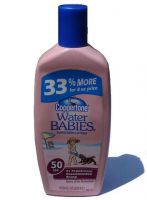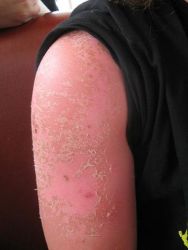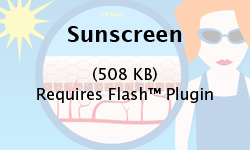Sun damage is a cumulative process, meaning that every moment of exposure has a long-term impact. Overexposure to the sun’s harmful ultraviolet (UV) radiation can cause burns, diseases, and cancers—substantially contributing to mortality rates in fair-skinned populations. The severity of skin cancer is real; there are more new cases of skin cancer than the combined figures for lung, breast, prostate, and colon cancers each year. Helping to protect against sunburn and skin cancer, sunscreen is a topical product that absorbs or reflects the sun’s UV light. It is important to consider the global impact of sunscreens and the scientific and engineering principles of this skin-care product. There have been recent advances in photoprotection, including the development of broad-spectrum sunscreen and the sun protection factor. Although sunscreens have been in use for over 70 years, their health applications are still being explored.
Introduction
Our sun—the most powerful entity in our corner of the universe—is dangerous. Almost everyone comes into contact with its rays every day. Whether you are walking your dog around the block or watching a 3-hour college football game in the stands at a stadium, your skin is at risk. It is well-known that solar radiation is harmful; you have probably taken a few precautions in the past to protect yourself from the sun’s intensity by wearing brimmed hats, polarized sunglasses, or high-SPF sunscreens (see Fig. 1). For many, lathering on sunscreen lotion may seem like a chore. But what exactly are you “applying liberally” to your body? How much protection does sunscreen really have to offer against sunburn and skin cancer, and how long will these safeguards last? The answers to these questions can be found by considering the scientific and engineering principles behind the $1.9 billion industry skin-care product: sunscreen.
A Harmful Sun
Natural sunlight contains, among other things, ultraviolet photon particles of light. These photons are shorter in wavelength and contain more energy than visible light, giving them the ability to cause DNA damage in skin cells. Ultraviolet radiation is broken down into the following three types of wavelengths:
- Ultraviolet, Type A (UVA)
- Ultraviolet, Type B (UVB)
- Ultraviolet, Type C (UVC)
On the Earth’s surface, we are exposed to UVA (wavelength 315-400 nm) and UVB (280-315 nm) photons; the UVC (100-280 nm) rays are completely absorbed by the atmosphere and never reach us. The longer wavelength UVA rays cause tanning and penetrate the deeper layers of skin, while the shorter wavelength UVB rays damage DNA and are the primary cause of sunburn and skin cancer. Since UV radiation falls outside of the visible light spectrum (rays between wavelength 400-700 nm), the human eye cannot perceive UV rays. Humans are also unable to feel UV radiation, leaving the body vulnerable with no mechanism to warn itself against overexposure.
The Sun’s Effects on Our Skin
Our skin is highly susceptible to critical damage from the sun’s ultraviolet rays; any exposure to UVA or UVB light can alter or damage it. Without protection, long-term exposure to natural sunlight inflicts damage on the skin cells, causing them to tan, burn, and peel.
Although a suntan is often considered an “emblem of good health,” tanning for its own sake has no health benefit and is actually a health hazard [1]. Tanning is your skin’s defense mechanism against the sun, and any change to your natural skin color is a sign of skin damage. When your skin is exposed to moderate levels of radiation, a chemical reaction in its cell system occurs. Your skin protects its complex structure of sensitive cells by producing a brownish pigment, called melanin, which absorbs and reflects UV rays, dissipating the energy as harmless heat. This is one of the reasons you heat up in the sun. Special pigment-producing cells called melanocytes manufacture these color capsules and send them to the surface of your skin, causing a “tanned” skin tone.
Dark-skinned people tan more quickly than fair-skinned people because dark skin already contains more melanin; because they have less melanin in their skin to serve as protection from the burning rays of the sun, fair-skinned people burn more easily [2]. Although tanning triggers your body’s manufacture of melanin, the body requires days or weeks to build up its supply, and if you are in the sun for an extended period of time, burning may occur.
As anyone who has had a sunburn knows, this localized skin injury leaves the skin red and in agonizing pain. A sunburn really is cellular damage caused by overexposure to the sun’s ultraviolet rays. Attempting to cool the heated skin area, your body increases its blood flow to the surface of the skin, so it can be cooled by evaporation and then returned to cool the internal organs, similar to the way a car radiator system works. Sometimes so much blood is pumped to the surface of the skin that it pushes through the thin walls of your blood vessels and permeates the other tissues, causing your skin to take on a reddish color. Your skin’s immune system then releases chemicals like histamine and serotonin, which trigger inflammation and the production of additional chemical compounds. Within 12 hours, skin cells begin to die, and the inflammation turns the skin a darker red [3].
After sunburn, your body will want to get rid of its damaged skin cells. Peeling is the abrupt acceleration of natural cell replacement, which causes gobs of dry skin to curl up and flake off (as shown in Fig. 2). This process is necessary because the damaged skin cells are at risk of “losing control” and becoming cancerous. The skin peel is a result of a mass “cell suicide,” or apoptosis, in which all damaged skin cells are instructed to die and be replaced by new cells underneath those layers. Sometimes, however, UV rays may damage the repair mechanisms and prevent the cells from “committing suicide,” thus allowing cancerous cells to replicate.
Cancer Risks
Skin cancer, the uncontrolled growth of skin cells, is the most common cancer in the world today, and the number of cases worldwide continues to increase each year. This year alone, over 1.3 million Americans will be diagnosed with skin cancer, and one out of every five Americans will be afflicted with skin cancer at least once during their lifetime [4].
Repeated exposure to UV rays can cause cancerous mutations such as malignant melanoma, the deadliest form of skin cancer. Melanoma is a skin tumor that develops in the melanocytes—pigment producing cells in the skin—and has a very high tendency to spread to other parts of the body. A study at the Anerson Cancer Center in Houston, Texas, concluded that about 1 in 105 Americans will develop melanoma, and 20 percent of those afflicted will die from the disease [5].
Interestingly, malignant melanoma has been found more frequently in sunscreen users than in non-users in some studies. This is because some sunscreens only work to prevent skin damage caused by UVB radiation but allow damage from UVA radiation to go unchecked. By preventing the pain and redness of sunburn, sunscreen may actually cause people to obliviously immerse themselves in skin-scorching sunlight for longer periods, resulting in more exposure to UVA radiation and putting users at a higher risk of developing melanoma.
Prevention: How Sunscreen Works
Many of the sunscreens available in the U.S. today combine several different active chemical ingredients in order to provide broad-spectrum protection by blocking both UVA and UVB rays. Sunscreens with broad-spectrum protection are effective in preventing sunburn and skin cancer. Sunscreens work by absorbing the UV radiation in the chemical bonds of their ingredients (see Fig. 3). Different brands of sunscreen contain different combinations of active ingredients that work together to minimize the impact of harmful rays. Some of these ingredients will deflect the UV light while others absorb it.
Most sunscreens work because they contain an organic chemical compound that absorbs ultraviolet light (such as oxybenzone), an opaque material that reflects light (such as zinc oxide), or a combination of both. The general structure of these principle ingredients allows molecules to absorb high-energy ultraviolet rays and release the energy as lower-energy rays, thereby preventing skin-damaging radiation from reaching the skin. Like a screen door, sunscreen filters the light from the sun, so that less of it reaches the deeper layers of skin. The principal ingredients in sunscreens are usually aromatic molecules conjugated with carbonyl groups, which prevent significant chemical change and allow the ingredients to retain their UV-absorbing potency without significant photo-degradation.
As their ingredients absorb UV energy, sunscreens begin to deteriorate and lose effectiveness. Thus, sunscreen must be applied before sun exposure in order to bind to the skin, and then be reapplied every two hours (regardless of their assigned SPF) in order to be effective in preventing skin cancer and sunburn. Sunblock, on the other hand, remains on the surface of the skin to reflect the UV radiation. The agents in sunblock—titanium oxide (TiO2) and zinc oxide (ZnO) —reflect the UV light so that it does not reach the skin. Since it does not require time to bind to the skin, sunblock is very effective in blocking all types of UV rays immediately upon application. However, because it remains on the skin’s surface, it is easily removed by friction from towels or clothing, perspiration, or other usual daily activities.
The ability of sunblock to protect the skin from UV rays depends on its Sun Protection Factor, which appears on sunscreen labels as “SPF.” SPF is a worldwide standard for measuring the effectiveness of a sunscreen’s ability to prevent UVB radiation from damaging the skin. The higher the SPF, the more protection a sunscreen will provide against UVB radiation and sunburn. For example, if it takes 20 minutes for your unprotected skin to start turning red, using an SPF 15 sunscreen will prevent the reddening by 15 times—or for about five hours. SPF 15 blocks 93% of all incoming UVB rays, SPF 30 blocks 97% and SPF 50 blocks 99% [6]. As you can see, no sunscreen can block all UV rays.
Because the SPF only accounts for UVB rays, certain sunscreens may not protect against UVA rays, which are known to cause photoaging, wrinkles, brownspots, and melanoma. Because of this curtailed protection, these sunscreens do not necessarily prevent skin cancer. To deliver true broad-spectrum protection, products must block UVA radiation in addition to UVB radiation.
Conclusion
Despite its dangers to skin cells, the sun is an important ally when it comes to good health. Optimal physical and mental wellbeing requires some degree of exposure to the sun. Ultraviolet light enables the body to produce Vitamin D, a vital substance that works against the formation of tumors and aids in the absorption of calcium. Some scientists have suggested that short periods of unprotected sun exposure are beneficial and will enhance the body’s Vitamin-D-production capabilities [2]. Not only does sunlight strengthen the body to combat disease, but it also boosts mental and emotional defenses against depression and fatigue. Bell Labs, Inc. has demonstrated sunlight to be a significant factor in maintaining a healthy mood and energy level [4].
The scientific and engineering principles of sunscreen illustrate a solution with global impact, prolonging the lives of many by deterring skin cancer development. Utilizing chemical properties, sunscreen protects the skin by absorbing harmful UV radiation, effectively screening out the sun’s rays. New sun-care technologies such as the Sun Pill™, a convenient daily-dose tablet that has been developed to offer medicinal protection from the sun, can minimize the sun’s harmful effects easily. By practicing routine skin protection, we can aim for a healthy level of sun exposure, a practice to be enjoyed in moderation.






